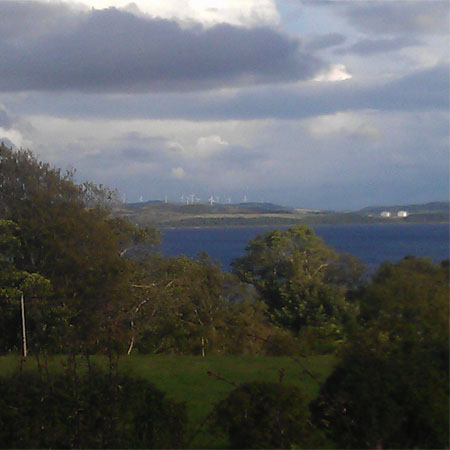It hasn’t been long since The Buteman reported that the planning application for three wind turbines at Ascog Farm was lodged.
In the week that has followed about twenty comments have been made by members of the public on the Argyll & Bute Council web site; 18 against and 2 for.
Unfortunately, despite all the news of perturbing climatic events world wide, these sorts of numbers are not unexpected.
Although Bute’s ‘landscape’ has been very largely man-made now for more than three hundred years some people still think that what they see around them is completely ‘unspoilt’ and ‘natural’.
Most objectors so far focus on the view out of their own windows whilst speculating that tourists won’t want to visit the place (contrary to most surveys into the effects of wind turbines on tourism, most recently this Scottish Government one) if some wind turbines actually get built.
No-one ‘owns’ the view of course, whilst some tourists might be more put off by persistent Island-wide power cuts or even the thought that Rothesay, Bute’s main town, has been nominated for the notorious Plook on the Plinth award.
As Tory MEP Struan Stevenson, who apparently ‘had no need to visit [Ascog]’, before delivering his wrathful intervention criticising the idea of wind turbines at the site has sought to establish, we are apparently living in some sort of primordial and seemingly divine nirvana.
Maybe that’s because he and his supporters believe the sort of anti-wind-turbine trash dished up by The Daily Mail or The Daily Telegraph. The sort that recently got Tory Junior Energy Minister John Hayes into a little bit of hot water with his LibDem boss and sparked denials of any change in renewable energy policy by the Prime Minister, David Cameron.
Looking from the top of the Hill of Ascog, of course, one can see around 30-40 wind turbines, together with the Coal and Nuclear plants at Hunterson. Even taken on a cameraphone it is clear that these structures are an existing landscape element. Bute’s landscape does not stop where the sea begins!

Turbines to the left of it, Nukes to the right!
As the ferry runs astern out of Wemyss Bay a turbine is visble on the top of the hill above the quay and so, as the ferry crosses, are the many much larger turbines along the Ayrshire coast.
Bute itself currently hosts three turbines at Ardbeg, greeting visitors as they enter Rothesay Bay, together with a small community turbine situated at the Joint Campus school.
Does anyone ask the Master to turn back the ship in the face of all this horror? No.
Perhaps there is some deep blue water that separates Bute, and its residents, from what has been built elsewhere in Scotland or, indeed, only a few miles from its shores?
‘No man is an island’ as metaphysical poet John Donne (1572-1631) would have it in his masterpiece:
No man is an island,
Entire of itself.
Each is a piece of the continent,
A part of the main.
If a clod be washed away by the sea,
Europe is the less.
As well as if a promontory were.
As well as if a man or of thine own
Or of thine friend’s were.
Each man’s death diminishes me,
For I am involved in mankind.
Therefore, send not to know
For whom the bell tolls,
It tolls for thee.
Isolation and Island life can bring advantages – a much-felt sense of community and, probably, a lower crime rate – for example – than on the mainland.
However, the fact that Bute is separated from the mainland by only a few miles does not make it immune from all of the issues that affect everyone.
Nuclear power? Just a few miles away! Wind energy on a huge scale? Just a few miles away! Rising wholesale gas prices causing rising energy bills? Yes, here too! An ever-changing world? All around!
The fact that it is windy on Bute should, really, be seen as an asset for the place – as it has been on other Scottish islands such as Gigha and Lewis – and not ignored: Do not ‘diminish’ what Bute has nor seek to ‘send not to know’…
Ask not for whom the bell tolls, it tolls for thee…